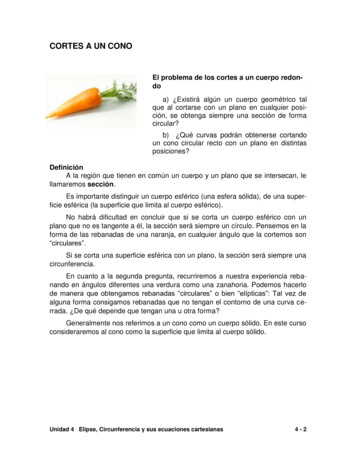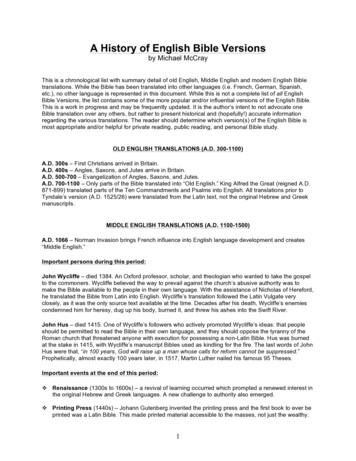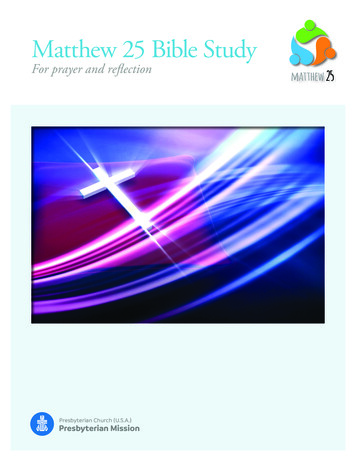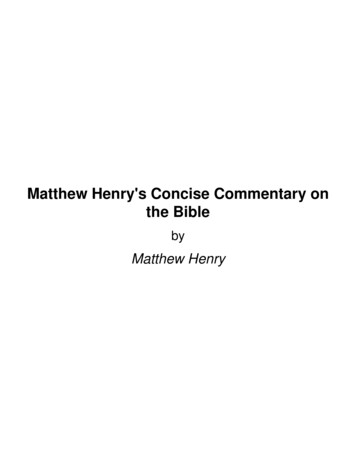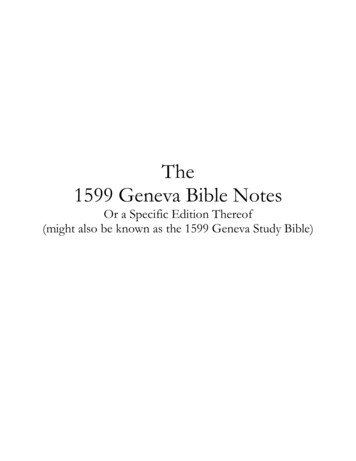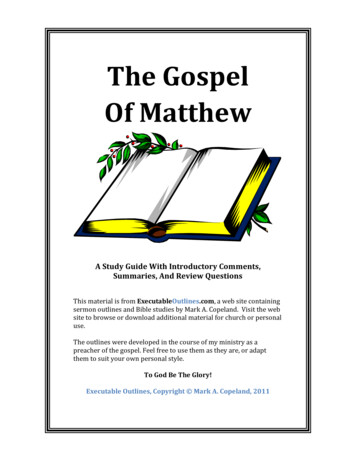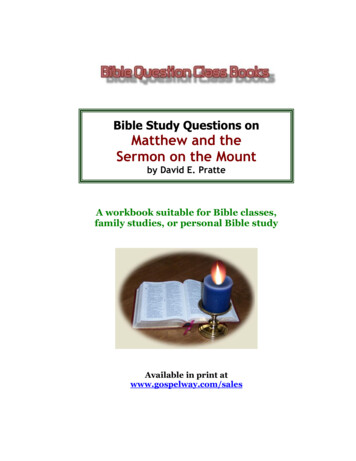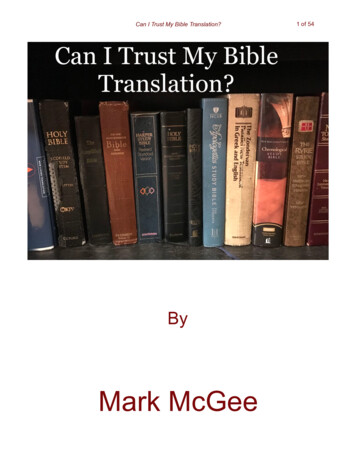
Transcription
Notes onMatthew2 0 2 2 E d i t i o nDr. Thomas L. ConstableTHE SYNOPTIC PROBLEMThe synoptic problem is intrinsic to all study of the Gospels, especially thefirst three.1 The word synoptic comes from two Greek words, syn andopsesthai, meaning, "to see together." Essentially the synoptic probleminvolves all the difficulties that arise because of the similarities anddifferences between the Gospel accounts.2 Matthew, Mark, and Luke havereceived the title "Synoptic Gospels" because they present the life andministry of Jesus Christ similarly. The content and purpose of John's Gospelare sufficiently distinct to put it in a class by itself. It is not one of the socalled Synoptic Gospels.The same or similar materialUnique 1"Gospel"capitalized in these notes refers to a book of the Bible, whereas "gospel"lowercased refers to the good news, the gospel message.2See W. Graham Scroggie, A Guide to the Gospels, pp. 83-93; Merrill C. Tenney, The NewTestament: An Historical and Analytic Survey, pp. 213-15.3Table adapted from Stanley D. Toussaint, "Matthew," in Surveying the Gospels and Acts,p. 12.Copyright Ó 2022 by Thomas L. Constable
Dr. Constable's Notes on Matthew22022 EditionAll four of the Gospels are selective accounts of the life and work of JesusChrist, whose "career was destined to change the history of the world moreprofoundly than that of any other single individual who ever lived."1"The Gospels are the most important part of Holy Scripturebecause all that preceded them led up to them, and all thatfollows emerges from them. If the revelation of the Gospelswere to be removed, the Old Testament would be an enigma,and the remainder of the New Testament would never havebeen written. These two parts of the Bible, comprising sixtytwo of its sixty-six Books, derive their value from the fourwhich we call the Gospels."2Part of the synoptic problem is determining the sources that the Holy Spiritled the evangelists to use in producing their Gospels. There is internalevidence (within the individual Gospels themselves) that the writers usedsource materials as they wrote. The most obvious example of this is theOld Testament passages to which each one referred directly or indirectly.Since Matthew and John were disciples of Jesus Christ, many of theirstatements represent eyewitness accounts of what happened. Likewise,Mark had close connections with Peter, and Luke was an intimate associateof Paul as well as a careful historian (Luke 1:1-4). Information that thewriters obtained verbally (oral tradition) and in writing (documents)undoubtedly played a part in what they wrote. Perhaps the evangelists alsoreceived special revelations from God before and/or when they wrote theirGospels.Some scholars have devoted much time and attention to the study of theother sources the evangelists may have used. They are the "source critics"and their work constitutes "source criticism." Because source criticism andits development are so crucial to Gospel studies, a brief introduction to thissubject follows.3In 1776 and 1779, two posthumously published essays by A. E. Lessingbecame known, in which he argued for a single written source for theSynoptic Gospels. He called this source the Gospel of the Nazarenes, and1AbramSachar, A History of the Jews, p. 124.p. 476.3For a longer discussion, see Donald A. Carson and Douglas J. Moo, An Introduction to theNew Testament, pp. 54-73, 79-112.2Scroggie,
2022 EditionDr. Constable's Notes on Matthew3he believed its writer had composed it in the Aramaic language. To him,one original source best explained the parallels and differences betweenthe Synoptics. This idea of an original source or primal Gospel caught theinterest of many other scholars. Some of them believed there was a writtensource, but others held that it was an oral source.As one might expect, the idea of two or more sources occurred to somescholars as the best solution to the synoptic problem (e.g., H. J. Holtzmannand B. H. Streeter). Some favored the view that Mark was one of the primalsources because over 90 percent of the material in Mark also appears inMatthew and/or Luke. Some proposed another primary source, "Q," anabbreviation of the German word for source: quelle. It supposedly containedthe material in Matthew and Luke that does not appear in Mark.Gradually, source criticism gave way to "form criticism." The "form critics"concentrated on the process involved in transmitting what Jesus said anddid to the primary sources. They assumed that the process of transmittingthis information followed patterns of oral communication that are typical inprimitive societies. Prominent New Testament form critics include K. L.Schmidt, Martin Dibelius, and Rudoph Bultmann. Typically, oralcommunication has certain characteristic effects on stories: It tends toshorten narratives, to retain names, to balance teaching, and to elaborateon stories about miracles, to name a few results.The critics also adopted other criteria from secular philology (the study oflanguage and languages) to assess the accuracy of statements in theGospels. For example, they viewed as distinctive to Jesus only what wasdissimilar to what Palestinian Jews or early Christians might have said. Giventhe critics' view of inspiration, it is easy to see how most of them concludedthat the Gospels, in their present form, do not accurately represent whatJesus said and did. However, some conservative scholars have used thesame literary method but held a much higher view of the Gospel: forexample, Vincent Taylor, who wrote The Gospel According to St. Mark.The next wave of critical opinion, "redaction criticism," began to influencethe Christian world shortly after World War II. A redactor is an editor. TheGerman scholar Gunther Bornkamm began this "school" of thought with anessay in 1948, which appeared in English in 1963.1 Redaction critics1GuntherBornkamm, "The Stilling of the Storm in Matthew," In Tradition and Interpretationin Matthew, pp. 52-57.
4Dr. Constable's Notes on Matthew2022 Editiongenerally accept the tenets of source and form criticism. However, theyalso believe that the Gospel evangelists altered the traditions that theyreceived in order to make their own theological emphases. They viewed thewriters not simply as compilers of the church's oral traditions, but astheologians who adapted the material for their own purposes. They viewedthe present Gospels as containing both traditional material and editedmaterial.There is a good aspect and a bad aspect to this view. Positively, itrecognizes the individual evangelist's distinctive purpose for writing.Negatively, it permits an interpretation of the Gospel that allows forhistorical error, and even deliberate distortion. Redaction scholars havebeen more or less liberal in their theology, depending on their view ofScripture generally. Redaction critics also characteristically show moreinterest in the early Christian community, out of which the Gospels came,and the beliefs of that community, than they do in Jesus' historical context.Their interpretations of the early Christian community vary greatly, as onewould expect. In recent years, the trend in critical scholarship has beenconservative, to recognize more rather than less Gospel material as havinga historical basis.Some knowledge of the history of Gospel criticism is helpful for the seriousstudent who wants to understand the text. Questions of the historicalbackground out of which the evangelists wrote, their individual purposes,and what they simply recorded or what they commented on—all affectinterpretation. Consequently, the theologically conservative expositor canprofit somewhat from the studies of scholars who concern themselves withthese questions primarily.1Most critics have concluded that one source that the writers used was oneor more of the other Gospels. Currently most source critics believe thatMatthew and Luke drew information from Mark's Gospel. Mark's accountsare generally longer than those of Matthew and Luke, suggesting thatMatthew and Luke condensed Mark. To them, it seems more probable thatthey condensed him, than that he elaborated on them. There is no directevidence, however, that one evangelist used another as a source. Sincethey were either personally disciples of Christ, or in close contact with1Fora conservative evaluation of the usefulness of redaction criticism, see D. A. Carson,"Redaction Criticism: On the Legitimacy and Illegitimacy of a Literary Tool," in Scriptureand Truth, pp. 119-42.
2022 EditionDr. Constable's Notes on Matthew5eyewitnesses of His activities, they may not have needed to consult anearlier Gospel.Most source critics also believe that the unique material in each Gospelgoes back to Q. This may initially appear to be a document constructed outof thin air. However, the early church father Papias (A.D. 80-155) may havereferred to the existence of such a source. Eusebius, the fourth-centurychurch historian, wrote that Papias had written, "Matthew composed thelogia [sayings? Gospel?] in the hebraidi [Hebrew? Aramaic?] dialekto[dialect? language? style?]."1 This is an important statement for severalreasons, but here note that Papias referred to Matthew's logia. This maybe a reference to Matthew's Gospel, but many source critics believe itrefers to a primal document that became a source for one or more of ourGospels. Most of them do not believe that Matthew wrote Q. They see inPapias' statement support for the idea that primal documents such asMatthew's logia were available as sources, and they conclude that Q wasthe most important one.Another major aspect of the synoptic problem is the order in which theGospels appeared as finished products. This issue has obvious connectionswith the question of the sources that the Gospel writers may have used.Until after the Reformation, almost all Christians believed that Matthewwrote his Gospel before Mark and Luke wrote theirs; they held Mattheanpriority. They did this largely because some of the early church fatherscommented on Matthew's priority (e.g., Irenaeus, Eusebius, and Jerome).2From studying the similarities and differences between the Synoptics, somesource critics also concluded that Matthew and Luke came into existencebefore Mark. They viewed Mark as a condensation of the other two. Someof the leaders in this movement were J. A. Eichorn, J. G. Herder, and J. J.Griesbach. The Tübingen school of scholars in Germany was also influentialin promoting this view.However, the majority of source critics today, as well as many evangelicalscholars, believe that Mark was the first Gospel and that Matthew and Lukewrote later. As explained above, they hold this view because they believeit is more probable that Matthew and Luke drew from and expanded on1TheEcclesiastical History of Eusebius Pamphilus, 3:39:16.R. V. G. Tasker, The Gospel According to St. Matthew: An Introduction andCommentary, p. 11.2See
6Dr. Constable's Notes on Matthew2022 EditionMark, than that Mark condensed Matthew and Luke. However, the numberof scholars who hold Matthean priority is increasing.1Since source criticism is highly speculative, many conservative Bibleexpositors (people who explain or describe the Bible) today continue tolean toward Matthean priority. We—I put myself in this group—do sobecause there is no solid evidence to contradict this traditional view, whichChristians held almost consistently for the church's first 17 centuries.While the study of deducing which Gospel came first, and who drew fromwhom or what, appeals to many students of Scripture, these issues areessentially academic ones. They have little to do with the meaning of thetext. Consequently I do not plan to discuss them further, but will referinterested students to the vast body of literature that is available. I will,however, deal with problems involving the harmonization of the Gospelaccounts at the appropriate places in the exposition that follows. The Bibleexpositor's basic concern is not the history of the stories in the text, buttheir primary significance in their contexts. One conservative scholar spokefor many others when he wrote the following:" it is this writer's opinion that there is no evidence topostulate a tradition of literary dependence among theGospels. The dependence is rather a parallel dependence onthe actual events which occurred."2A much more helpful critical approach to the study of the Bible is "literarycriticism," which is the current wave of interest. This approach analyzesthe text in terms of its literary structure, emphases, and unique features.It seeks to understand the canonical (final form) text as a piece of literatureby examining how the writer wrote it. Related to this approach is "rhetoricalcriticism," which analyzes the text as a piece of rhetoric (persuasivespeech). This approach is helpful because there are so many speeches inthe Gospels.1E.g.,William R. Farmer, The Synoptic Problem. See also C. S. Mann, Mark, pp. ix, 47-71,who argued that Mark's Gospel was the third Synoptic written.2Charles H. Dyer, "Do the Synoptics Depend on Each Other?" Bibliotheca Sacra 138:551(July-September 1981):244. See also Robert Jamieson, A. R. Fausset, and David Brown,Commentary Practical and Explanatory on the Whole Bible, p. 880.
2022 EditionDr. Constable's Notes on Matthew7GENREGenre refers to the type of literature that a particular document fits within.Certain types of literature have features that affect their interpretation.For example, we interpret letters differently than poems. So it is importantto identify the genre or genres of a book of the Bible.1The Gospels are probably more like ancient Greco-Roman biographies thanany other type of literature.2 This category is quite broad and encompassesworks of considerable diversity, including the Gospels. Even Luke, with itscharacteristic historiographic (written history) connections to Acts,qualifies as ancient biography. Unlike this genre, however, the Gospels"combine teaching and action in a preaching-oriented work that standsapart from anything else in the ancient world."3 The Gospels also areanonymous, in the sense that the writers did not identify themselves asthe writers, as Paul did in his epistles, for example. And they are not aspretentious as most ancient biographies. The word "gospel," by the way,comes from the old Saxon God's spell or word.4WRITERExternal evidence strongly supports the Matthean authorship of the firstGospel. The earliest copies of the Gospel we have begin: "KATAMATTHAION" ("according to Matthew"). Several early church fathersreferred to Matthew (whose name means "Gift of God" or "Faithful") as thewriter, including: Clement of Rome, Polycarp, Justin Martyr, Clement ofAlexandria, Tertullian, and Origen.5 Papias' use of the term logia to describeMatthew's work, cited above, is not clear evidence of Matthean authorshipof the first Gospel.6 Since Matthew was a disciple of Jesus and one of the12 Apostles, his work carried great influence and enjoyed much prestigefrom its first appearance. We might expect a more prominent disciple, suchas Peter or James, to have written it. The fact that the early church1SeeGordon Fee, "The Genre of New Testament Literature and Biblical Hermeneutics," inInterpreting the Word of God, pp. 119-23.2Carsonand Moo, pp. 112-15.p. 115.4Matthew Henry, Commentary on the Whole Bible, p. 1203.5For further attestation, see Norman L. Geisler and William E. Nix, A General Introductionto the Bible, p. 193.6See Edgar J. Goodspeed, Matthew: Apostle and Evangelist, p. 138.3Ibid.,
8Dr. Constable's Notes on Matthew2022 Editionaccepted it as from Matthew further strengthens the likelihood that heindeed wrote it.Internal evidence of Matthean authorship is also strong. As a tax collectorfor Rome, Matthew would have had to be able to write capably, he wouldhave been a note-taker and preserver (unlike Jews of his time in general),and he probably knew shorthand.1 His profession forced him to keepaccurate and detailed records, which skill he put to good use in composinghis Gospel. There are more references to money—and to more differentkinds of money—in this Gospel, than in any of the others.2 It has beenestimated that about one-fifth of Jesus' teachings dealt with moneymatters.3 Matthew humbly referred to himself as a tax collector, aprofession with objectionable connotations in his culture, whereas theother Gospel writers simply called him Matthew (or Levi). Matthewmodestly called his feast for Jesus "dining" (Matt. 9:9-10), but Lukereferred to it as "a big reception" (Luke 5:29).4 All these details confirmthe testimony of the early church fathers.5According to tradition, Matthew ministered in Palestine for several yearsafter Jesus' ascension to heaven. He also made missionary journeys to theJews who lived among the Gentiles outside Palestine, Diaspora Jews. Thereis evidence that he visited Persia, Ethiopia, Syria, and Greece.6"It was no ordinary man who wrote a Gospel which Renan, theFrench critic, eighteen hundred years later, could call the mostimportant book in the world. How many of our current bestsellers will still be leading human thought in A.D. 3600?"71Ibid.,pp. 101, 108, 117.Werner G. Marx, "Money Matters in Matthew," Bibliotheca Sacra 136:542 (April-June1979):148-57.3Craig L. Blomberg, Preaching the Parables, p. 83.4Quotations from the English Bible in these notes are from the New American StandardBible (NASB), 2020 edition, unless otherwise indicated.5See also Gregory Goswell, "Authorship and Anonymity in the New Testament Writings,"Journal of the Evangelical Theological Society 60:4 (December 2017):733-49.6Warren W. Wiersbe, The Bible Exposition Commentary, 1:13.7Goodspeed, p. 12.2See
2022 EditionDr. Constable's Notes on Matthew9LANGUAGEPapias' statement, cited above, refers to a composition by Matthew in thehebraidi dialekto (the Hebrew or possibly Aramaic language or dialect, thesame Greek word referring to both cognate languages). This may not be areference to Matthew's Gospel. Four other church fathers mentioned thatMatthew wrote in Aramaic and that translations followed in Greek: Irenaeus(A.D. 130-202), Origen (A.D. 185-254), Eusebius (fourth century), andJerome (fourth century).1 However, they may have been referring tosomething other than our first Gospel. These references have led manyscholars to conclude that Matthew composed his Gospel in Aramaic, andthat someone else, or he himself, later translated it into Greek. However,no other book of any kind, written in Aramaic, has thus far been found.2Another possibility is that Matthew took extensive notes in Aramaic andthen later composed his Gospel in Greek.3If Matthew originally wrote his Gospel in Aramaic, it is difficult to explainwhy he sometimes, but not always, quoted from a Greek translation of theOld Testament, the Septuagint.4 The Hebrew Bible (our Old Testament)would have been the normal text for a Hebrew or Aramaic author to use. AGreek translator might have used the Septuagint (abbreviated LXX) to savehimself some work, but if he did so—why did he not use it consistently?5Matthew's Greek Gospel contains many Aramaic words. This Aramaicoriginal view also raises some questions concerning the reliability andinerrancy of the Greek Gospel that has come down to us.There are several possible solutions to the problem of the language ofMatthew's Gospel.6 The best seems to be that Matthew wrote Aramaicnotes—that God did not inspire—that are no longer extant (available tous). He also composed an inspired Greek Gospel using these notes that hascome down to us in the New Testament. Many competent scholars believe1LouisA. Barbieri Jr., "Matthew," in The Bible Knowledge Commentary: New Testament,p. 15.2Goodspeed, pp. 47, 129, 138. He published this statement in 1959.3Ibid., pp. 48-494For background information on the Septuagint translation, see Frederic Kenyon, Our Bibleand the Ancient Manuscripts, pp. 97-113, 132-34.5The Septuagint is the translation of the Hebrew Bible into Greek that was made in thethird century B.C.6See Stanley D. Toussaint, Behold the King: A Study of Matthew, pp. 329-33, for fiveviews.
Dr. Constable's Notes on Matthew102022 Editionthat Matthew originally wrote his Gospel in Greek. They do so mainlybecause of his facility with the Greek language.1 Most modern scholars donot believe that the Gospel of Matthew is a translation of an Aramaicdocument.2"Archaeological evidence, as we see, does not support theview that the Gospels were written in Aramaic."3DATEDating Matthew's Gospel is difficult for many reasons, even if one believesin Matthean priority. The first extra-biblical reference to it occurs in thewritings of Ignatius (ca. A.D. 110-115).4 However, Matthew's referencesto Jerusalem and the Sadducees point to dates of composition before A.D.70, when the Romans destroyed Jerusalem. His references to Jerusalemassume its existence (e.g., 4:5; 27:53). Matthew recorded more warningsabout the Sadducees than all the other New Testament writers combined,but after A.D. 70 they no longer existed as a significant authority in Israel.5Consequently, Matthew probably wrote before A.D. 70.6References in the text to the customs of the Jews continuing "to this day"(27:8; 28:15) imply that some time had elapsed between the crucifixion ofJesus Christ and the composition of the Gospel. Since Jesus probably diedin A.D. 33, Matthew may have composed his Gospel perhaps a decade ormore later. A date between A.D. 40 and 70 is very probable. Some otherdates proposed by reliable scholars include between A.D. 50 and 60,7 or inthe 60s,8 though most scholars favor a date after A.D. 70.91See,for example, D. A. Carson, "Matthew," in Matthew-Luke, vol. 8 of The Expositor'sBible Commentary, p. 13.2Tasker,p. 13.F. Albright, The Archaeology of Palestine, p. 203.4To the Smyrneans 1:1.5Carson, "Matthew," pp. 20-21.6See also Carson and Moo, pp. 152-56.7Mark L. Bailey, "Matthew," in The New Testament Explorer, p. 2.8R. T. France, The Gospel of Matthew, p. 19; Darrell L. Bock, Jesus according to Scripture,p.30.9France, p. 19.3W.
2022 EditionDr. Constable's Notes on Matthew11Matthew appears first among the four Gospels in our canon, because whenthe church established the canon, Matthew was believed to have been thefirst one written, and the one with the most developed connection to theOld Testament.1PLACE OF COMPOSITIONSince Matthew lived and worked in Palestine, we would assume that hewrote while living there. There is no evidence that excludes this possibility.Nevertheless, scholars love to speculate. Other sites that they havesuggested include Antioch of Syria (Ignatius was bishop of Antioch),Alexandria, Edessa, Syria, Tyre, and Caesarea Maratima. These are allguesses.DISTINCTIVE FEATURES"If a Bible reader were to jump from Malachi into Mark, or Acts,or Romans, he would be bewildered. Matthew's Gospel is thebridge that leads us out of the Old Testament and into theNew Testament."2Compared with the other Gospels, Matthew's is distinctively Jewish. Heused parallelisms, as did many of the Old Testament writers, and histhought patterns and general style are typically Hebrew.3 Matthew'svocabulary (e.g., kingdom of heaven, holy city, righteousness, etc.) andsubject matter (e.g., the Law, defilement, the Sabbath, Messiah, etc.) arealso distinctively Jewish.Matthew referred to the Old Testament, especially Isaiah, more than anyother evangelist.4 The United Bible Society's Greek New Testament lists 54direct citations of the Old Testament in Matthew, plus 262 widelyrecognized allusions and verbal parallels. W. Graham Scroggie counted 1291Bock,p. 31. For a brief discussion of the New Testament canon, see Carson and Moo, pp.726-43.2Wiersbe, 1:10.3A. T. Robertson, A Grammar of the Greek New Testament in the Light of HistoricalResearch, p. 119.4Scroggie, p. 146; Goodspeed, p. 13.
12Dr. Constable's Notes on Matthew2022 EditionOld Testament references: 53 citations, and 76 allusions. He also claimedthat there are more references to the Psalms (29), Deuteronomy (27), andIsaiah (26) than to any other Bible books—representing all three parts ofthe Hebrew Bible: the Law, the Prophets, and the Psalms (cf. Luke 24:44).1Usually Matthew referred to the Old Testament, or quoted someone doingso, in order to prove a point to his readers. The genealogy in chapter 1traces Jesus' ancestry back to Abraham, the father of the Jewish race.Matthew gave prominent attention to Peter, the apostle to the Jews.2 Thewriter also referred to many Jewish customs without explaining them,evidently because he believed most of his original readers would not needan explanation.Another distinctive emphasis in Matthew is Jesus' teaching ministry. Noother Gospel contains as many of Jesus' discourses and instructions. Theseinclude the Sermon on the Mount (chs. 5—7), the charge to the apostles(ch. 10), the parables of the kingdom (ch. 13), the lesson on forgiveness(ch. 18), the denunciation of Israel's leaders (ch. 23), and the OlivetDiscourse (chs. 24—25).3 About 60 percent of the book focuses on Jesus'teachings. However, Matthew presented Jesus as a doer as well as ateacher. He referred to more than 20 miracles that Jesus performed.4Charles Ryrie counted 35 separate miracles of Christ recorded in theGospels: 20 related in Matthew, 18 in Mark, 20 in Luke, and seven in John.5I have listed 39 references to His miracles in Appendix 6, at the end ofthese notes.1Scroggie,p. 270.C. Allen, A Critical and Exegetical Commentary on the Gospel According to S.Matthew, p. lxxxi.3Robert H. Gundry, Matthew: A Commentary on His Literary and Theological Art, is anevangelical who believed in inerrancy, but he argued that parts of Matthew's Gospelpresent events that did not really happen in Jesus' life. This is a position that many liberalscholars have taken who refer to these non-historical stories as myth, legend, or heroicbiography. Gundry called them midrash, a Jewish embellishment that was common in nonbiblical writings of Matthew's time. See Scott Cunningham and Darrell L. Bock, "Is MatthewMidrash?" Bibliotheca Sacra 144:574 (April-June 1987):157-80, for a refutation ofGundry's position.4See Mark J. Larson, "Three Centuries of Objections to Biblical Miracles," Bibliotheca Sacra160:637 (January-March 2003):77-100.5Charles C. Ryrie, The Miracles of our Lord, p. 11.2Willoughby
2022 EditionDr. Constable's Notes on Matthew13"A miracle may be defined to be an event, in the externalworld, brought about by the immediate efficiency, or simplevolition of God."1The transitional nature of this Gospel is also evident in that Matthew alone,among the Gospel writers, referred to the church (16:18; 18:17). Herecorded Jesus' prediction of the church, as well as instruction about howHis disciples should conduct themselves in the church. God created thechurch in view of Israel's rejection of her Messiah (cf. 16:13-18; Rom. 11),though it was always in His eternal plan."Matthew reveals the King: then the Priest is seen in Mark: andthe ultimate Prophet in Luke."2AUDIENCE AND PURPOSESSeveral church fathers (i.e., Irenaeus, Origen, and Eusebius) stated whatwe might suppose from the distinctively Jewish emphases of this book,namely, that Matthew wrote his Gospel primarily for his fellow Jews.3He wrote, under the inspiration of the Holy Spirit, for a specific purpose or,more accurately, specific purposes. He did not state these purposesconcisely, as John did in his Gospel (John 20:30-31). Nevertheless they areclear from his content and his emphases."The author probably wrote primarily to persuade Jews thatJesus is the fulfillment of their Messianic hopes as pictured inthe Old Testament."4"Matthew has a twofold purpose in writing his Gospel. Primarilyhe penned this Gospel to prove Jesus is the Messiah, but healso wrote it to explain God's kingdom program to his readers.One goal directly involves the other. Nevertheless, they aredistinct."51CharlesHodge, Systematic Theology, 1:618.Campbell Morgan, The Unfolding Message of the Bible, p. 296.3Scroggie, pp. 248, 267-70.4A. T. Robertson, Word Pictures in the New Testament, 1:xiii.5Toussaint, Behold the , p. 18. See also Bailey, pp. 2-3.2G.
14Dr. Constable's Notes on Matthew2022 Edition"Matthew's purpose obviously was to demonstrate that JesusChrist was the promised Messiah of the Old Testament, thatHe fulfilled the requirements of being the promised King whowould be a descendant of David, and that His life and ministryfully support the conclusion that He is the prophesied Messiahof Israel. "As a whole, the gospel is not properly designated as only anapologetic for the Christian faith. Rather, it was designed toexplain to the Jews, who had expected the Messiah when Hecame to be a conquering king, why instead Christ suffered anddied, and why there was the resulting postponement of Histriumph to His second coming."1"This Gospel is in fact the history of His [Jesus'] rejection bythe people, and consequently that of the condemnation of thepeople themselves, so far as their responsibility was concerned and the substitution of that which God was going to bringin according to His purpose."2Matthew presented three aspects to God's kingdom program: First, Jesuspresented Himself to the Jews as the king that God had promised in theOld Testament. Second, Israel's leaders rejected Jesus as their king. Thisresulted in the postponement (or delay), not the cancellation, of themessianic kingdom that God had promised Israel. Third, because of Israel'srejection, Jesus is now building His church in anticipation of His return toestablish the promised messianic kingdom on the earth.3There are at least three wider purposes that Matthew undoubtedly hopedto fulfill with his Gospel: First, he wanted to instruct Christians and nonChristians concerning the person and work of Jesus.4 Second, he wantedto provide an apologetic to aid his Jewish brethren in witnessing to otherJews about
2See R. V. G. Tasker, The Gospel According to St. Matthew: An Introduction and Commentary, p. 11. 6 Dr. Constable's Notes on Matthew 2021 Edition Mark, than that Mark condensed Matthew and Luke. However, the number of scholars who hold Matthean priority is increasing.1 Since source criticis
